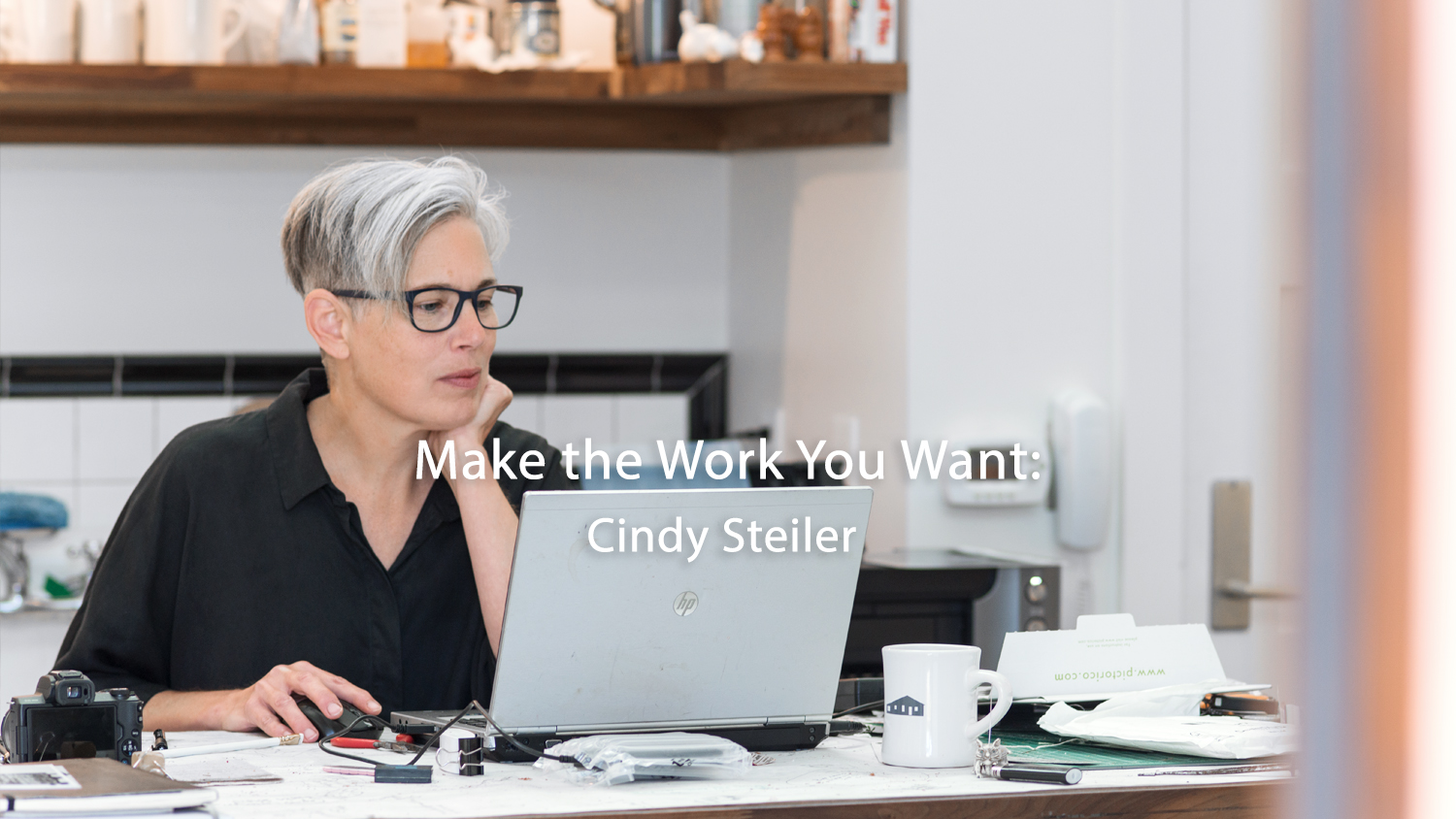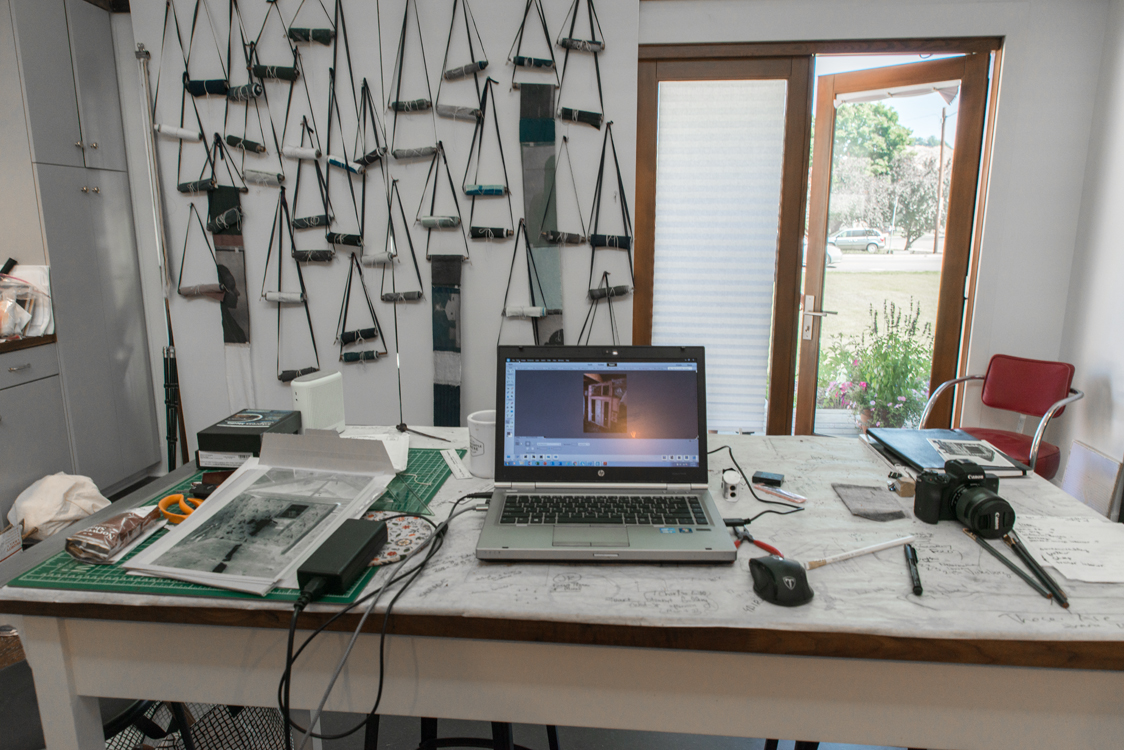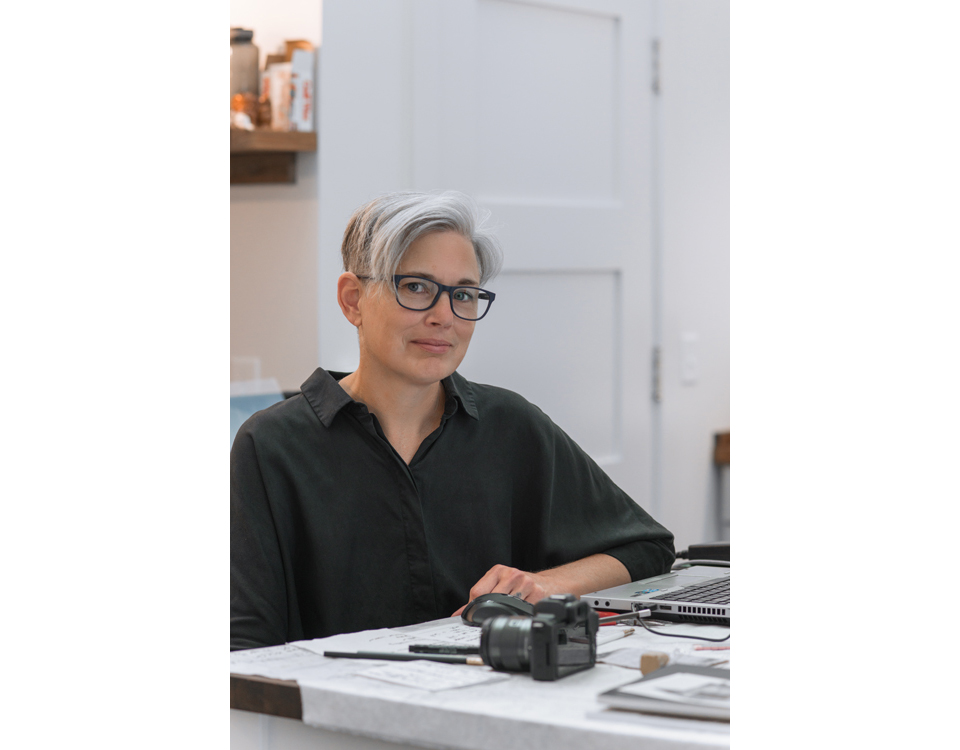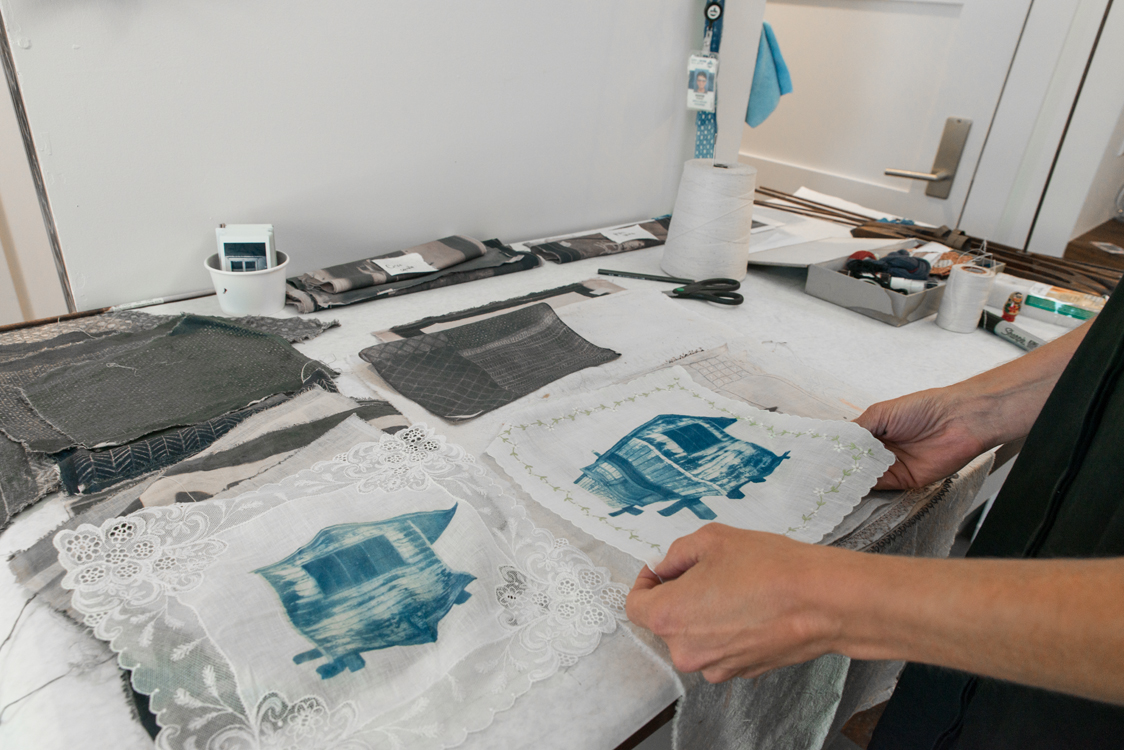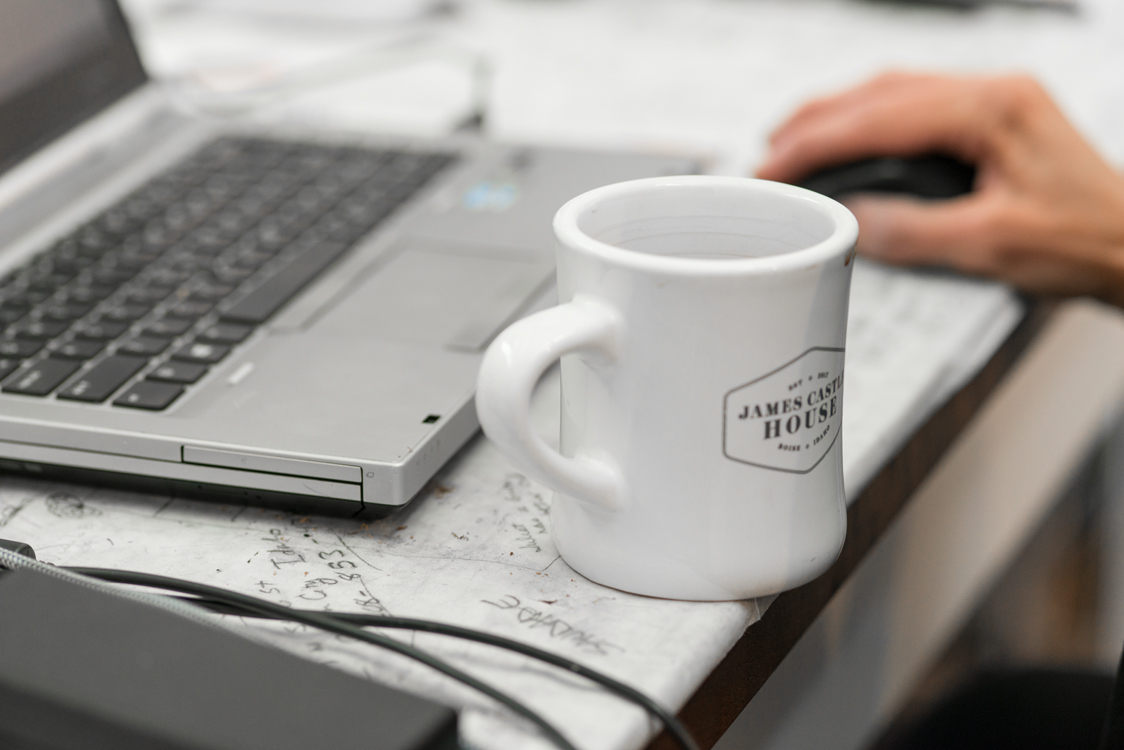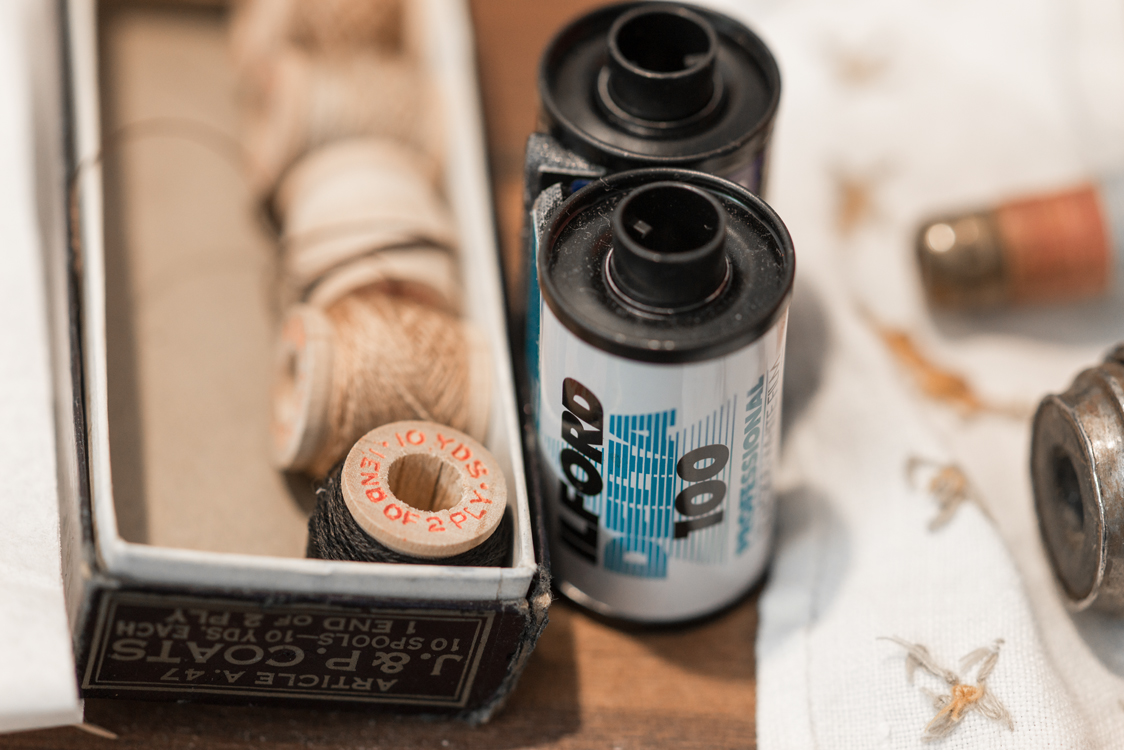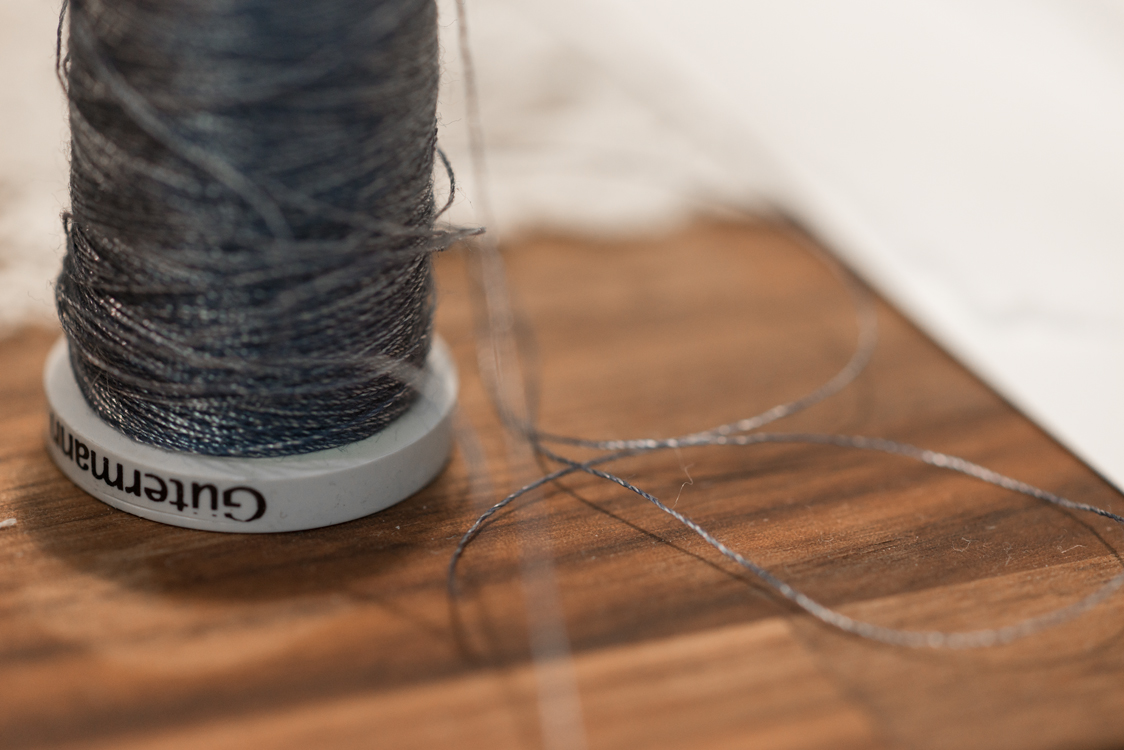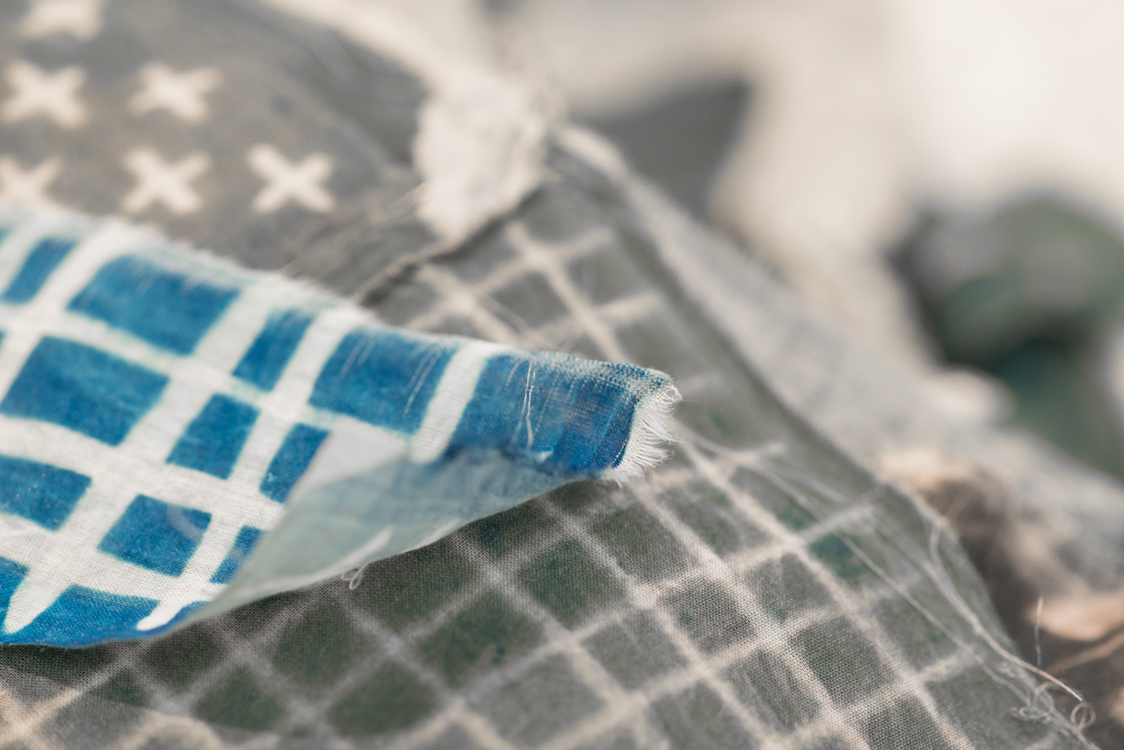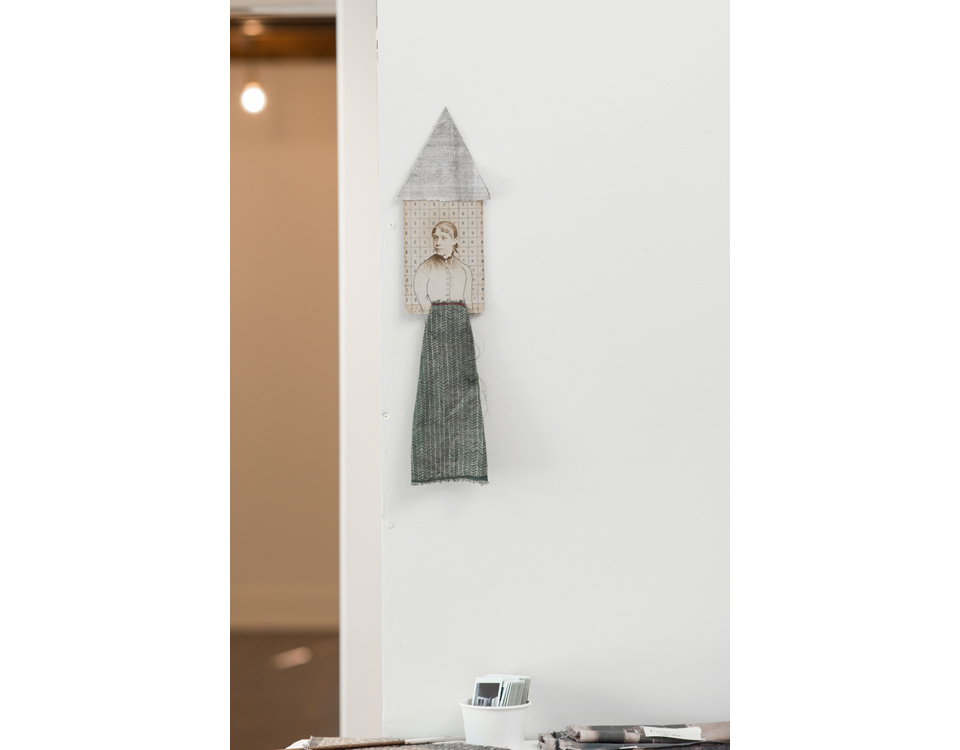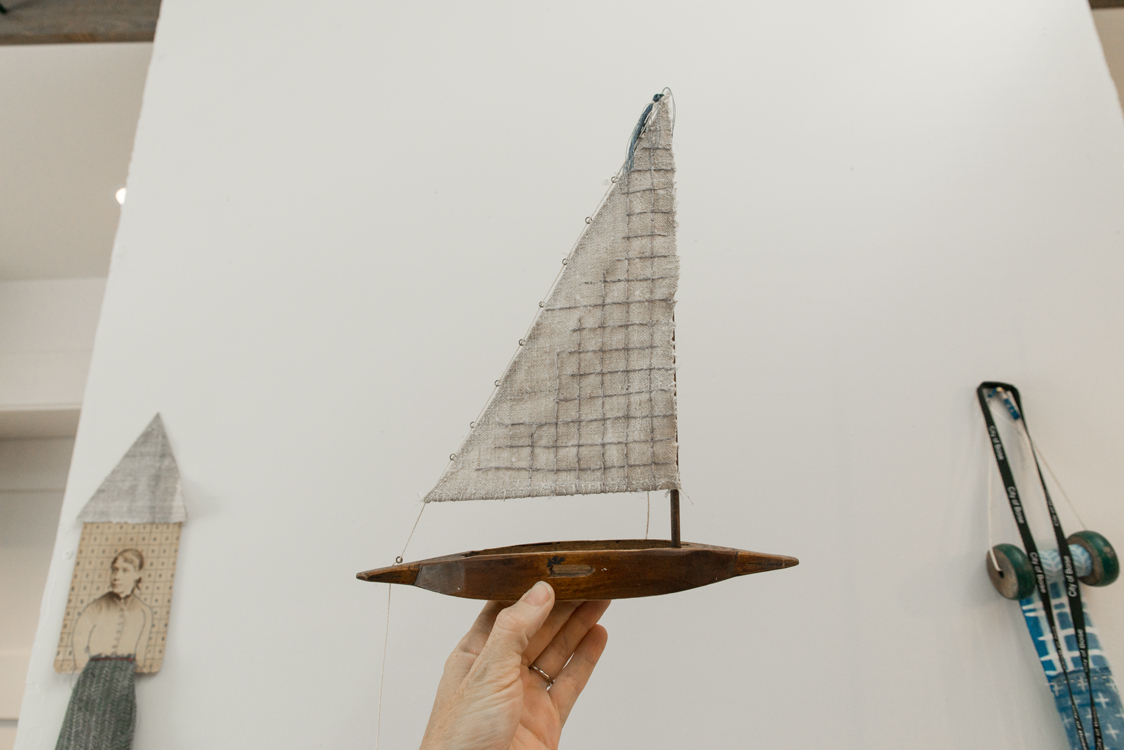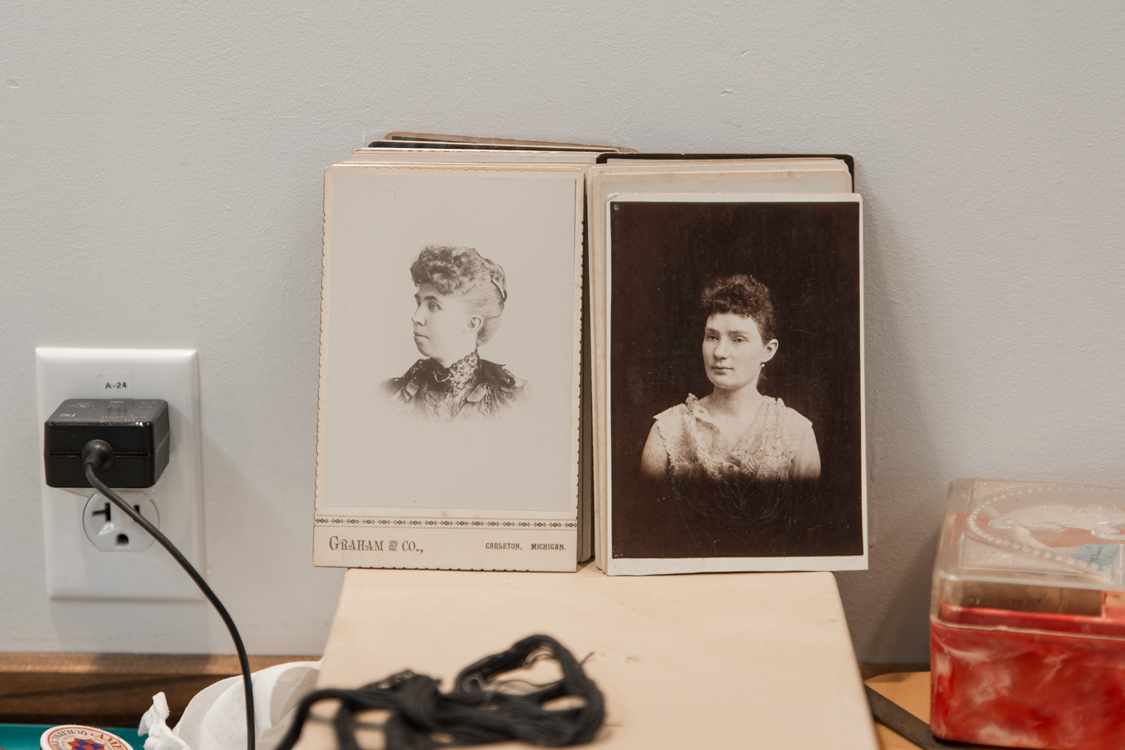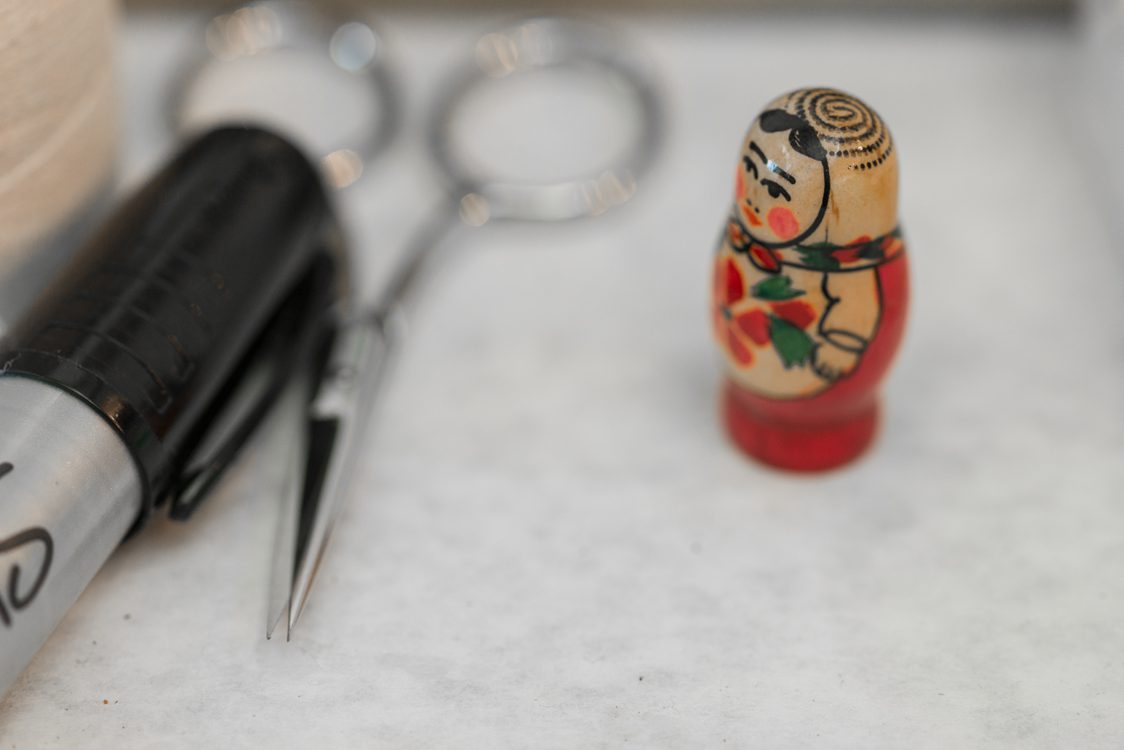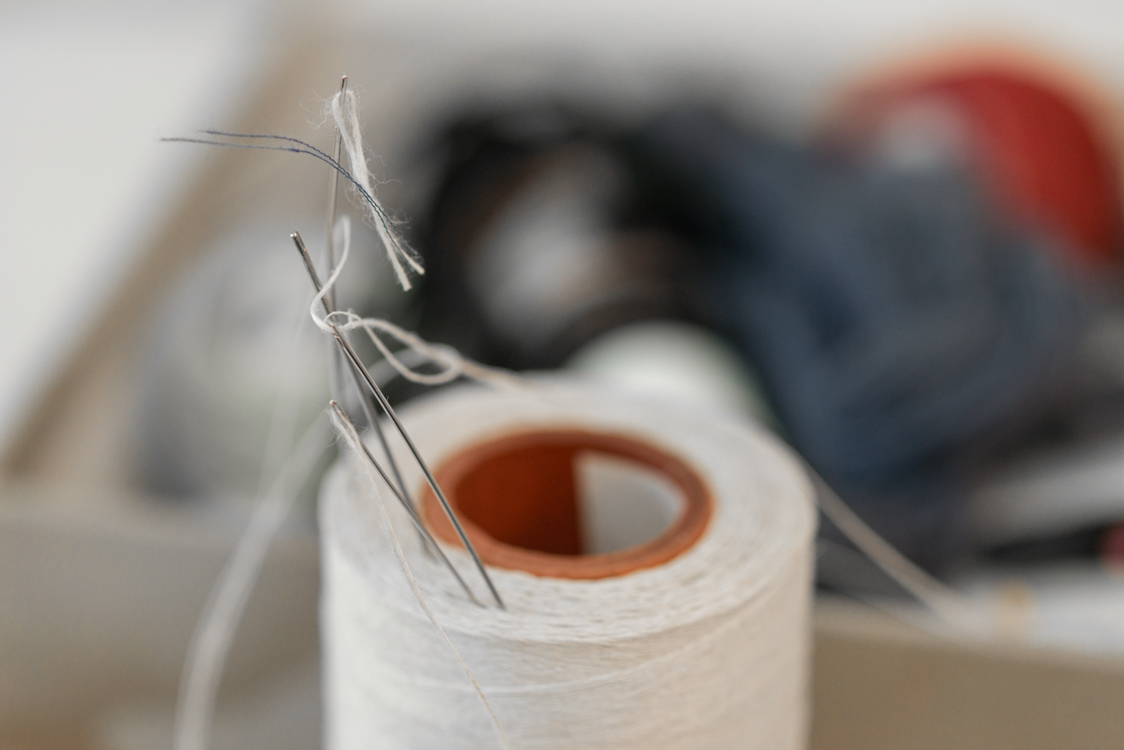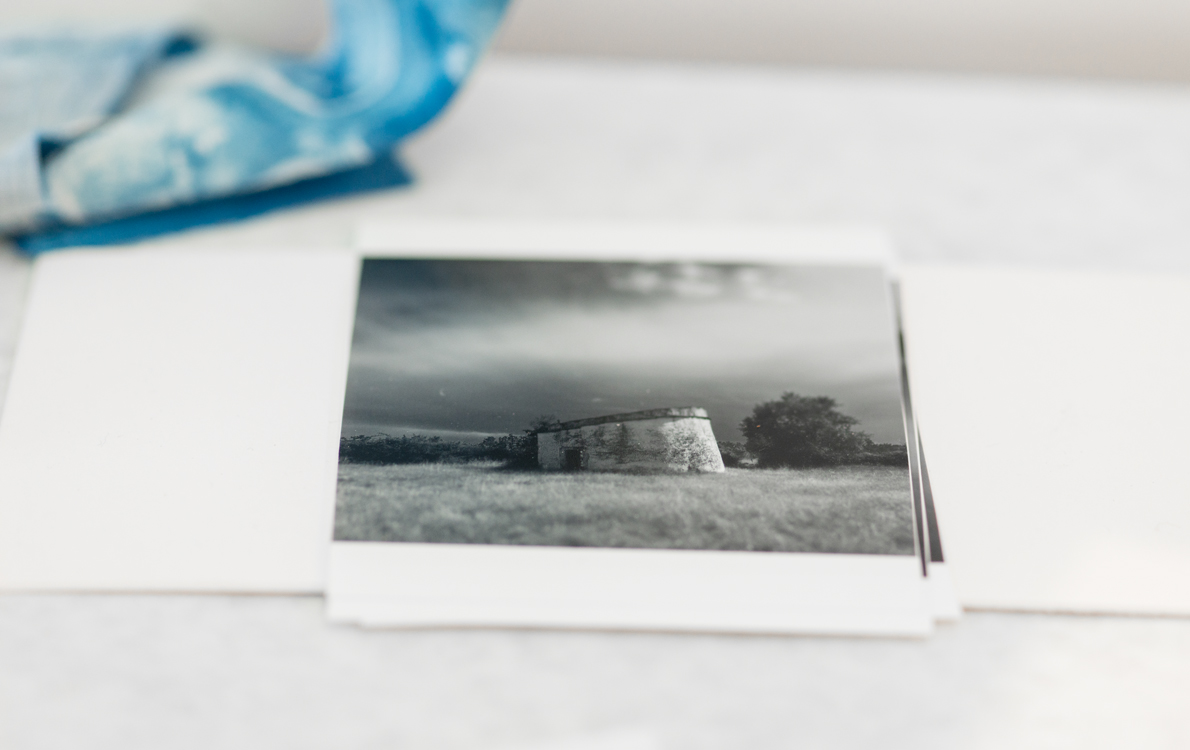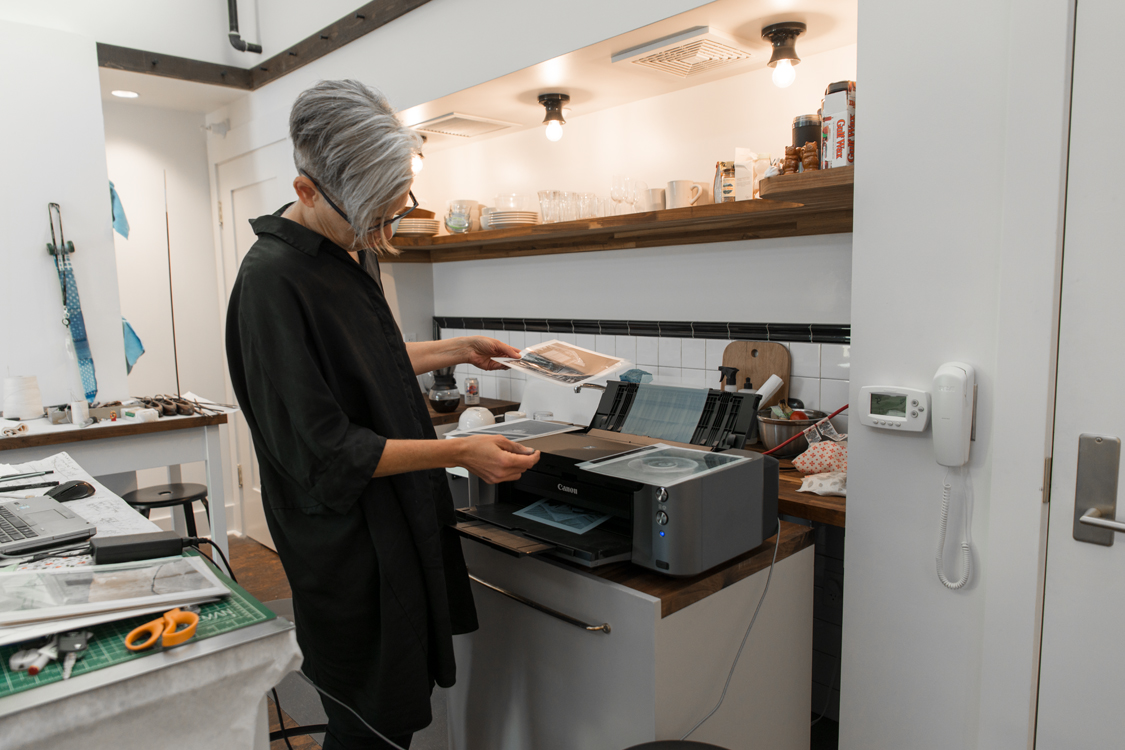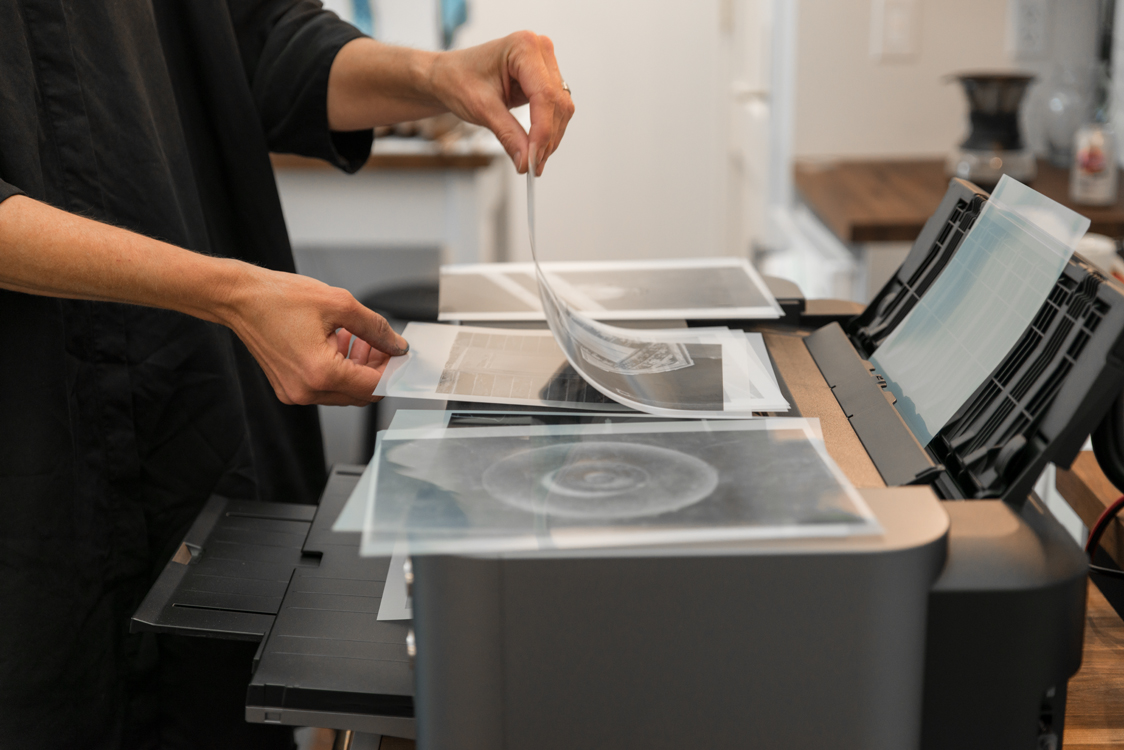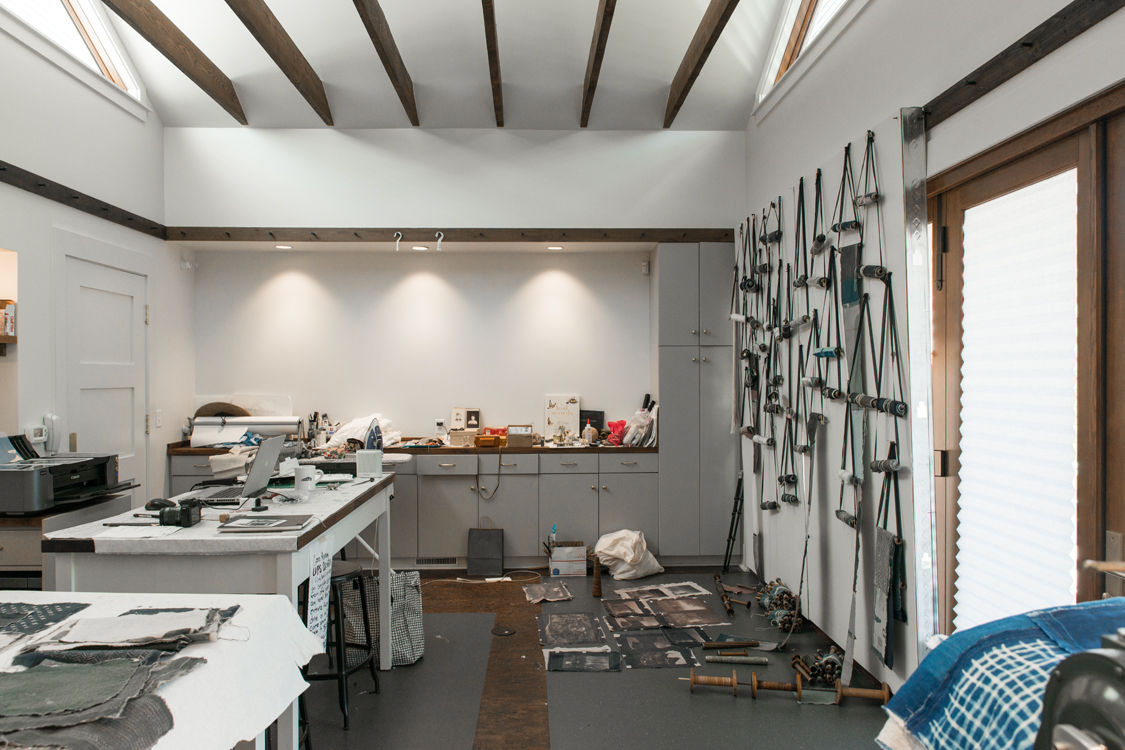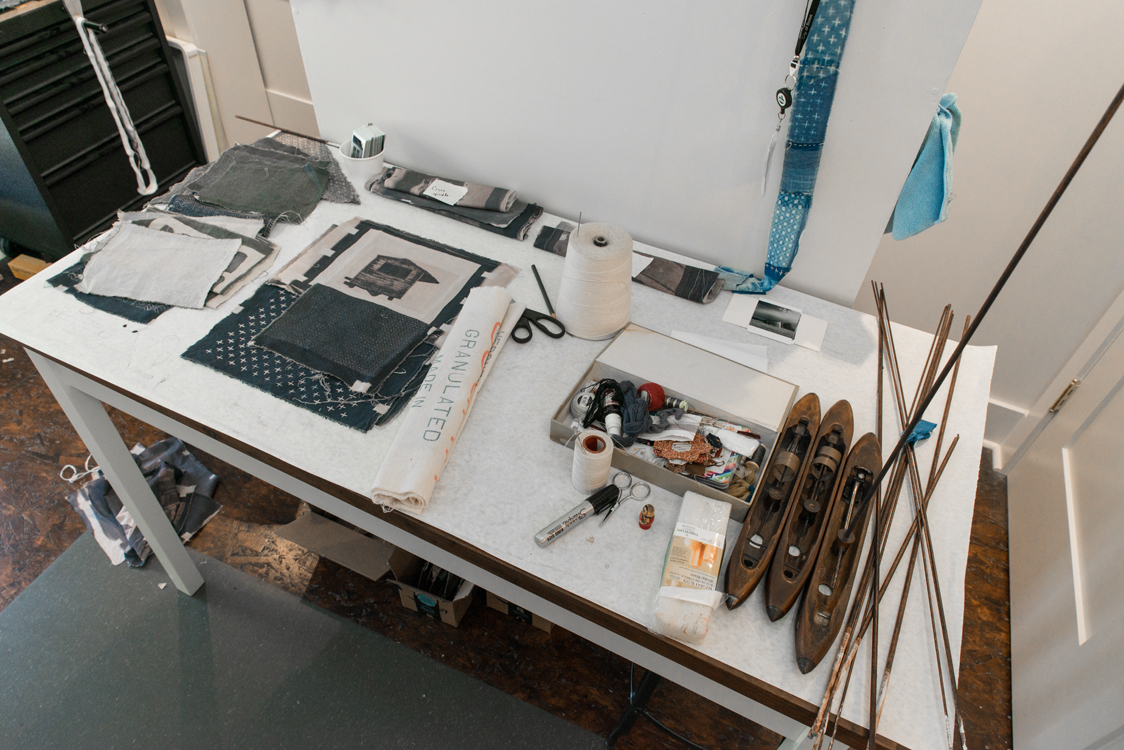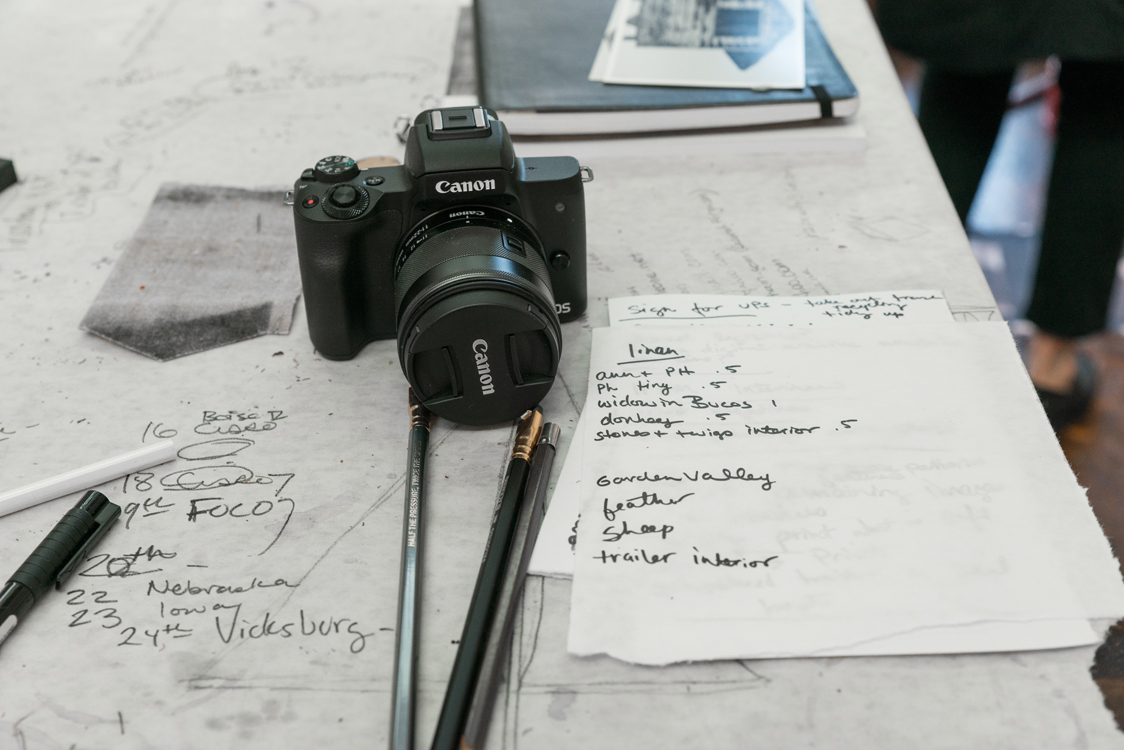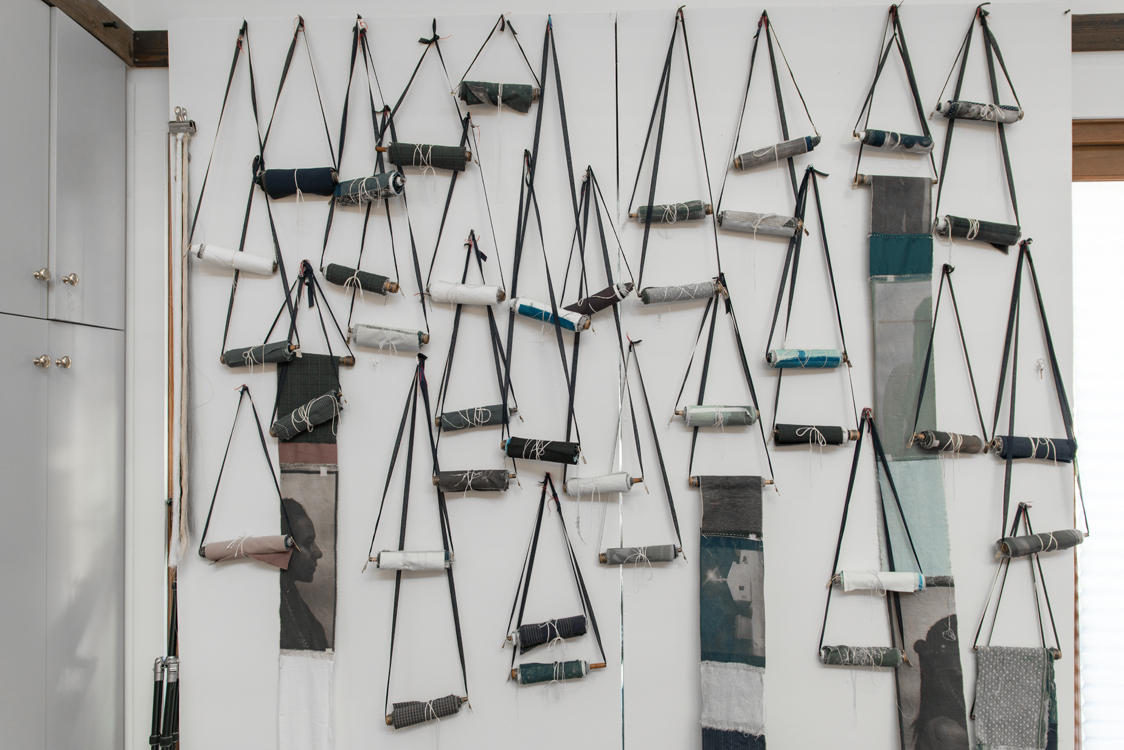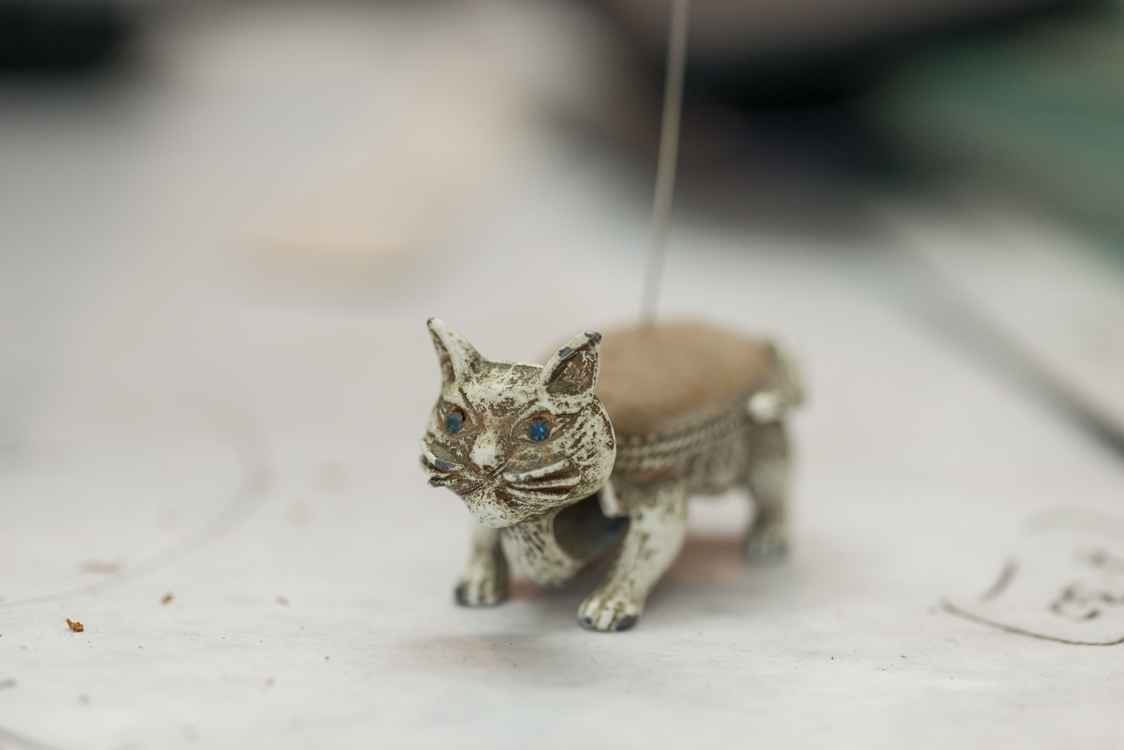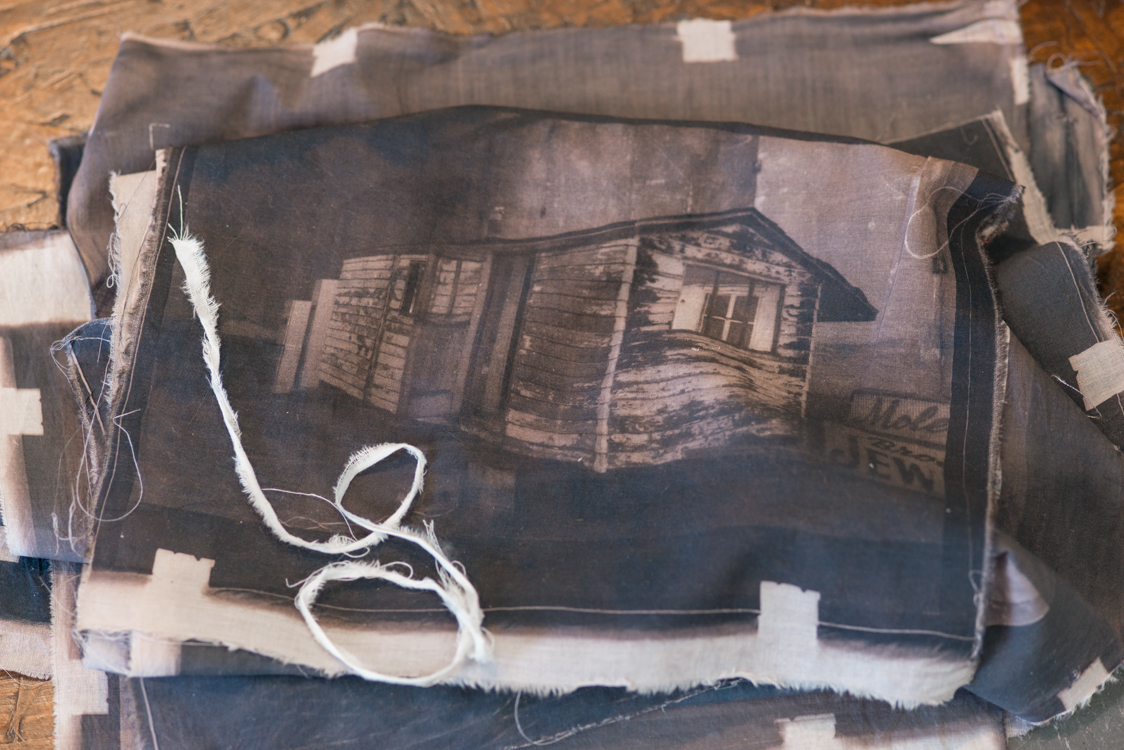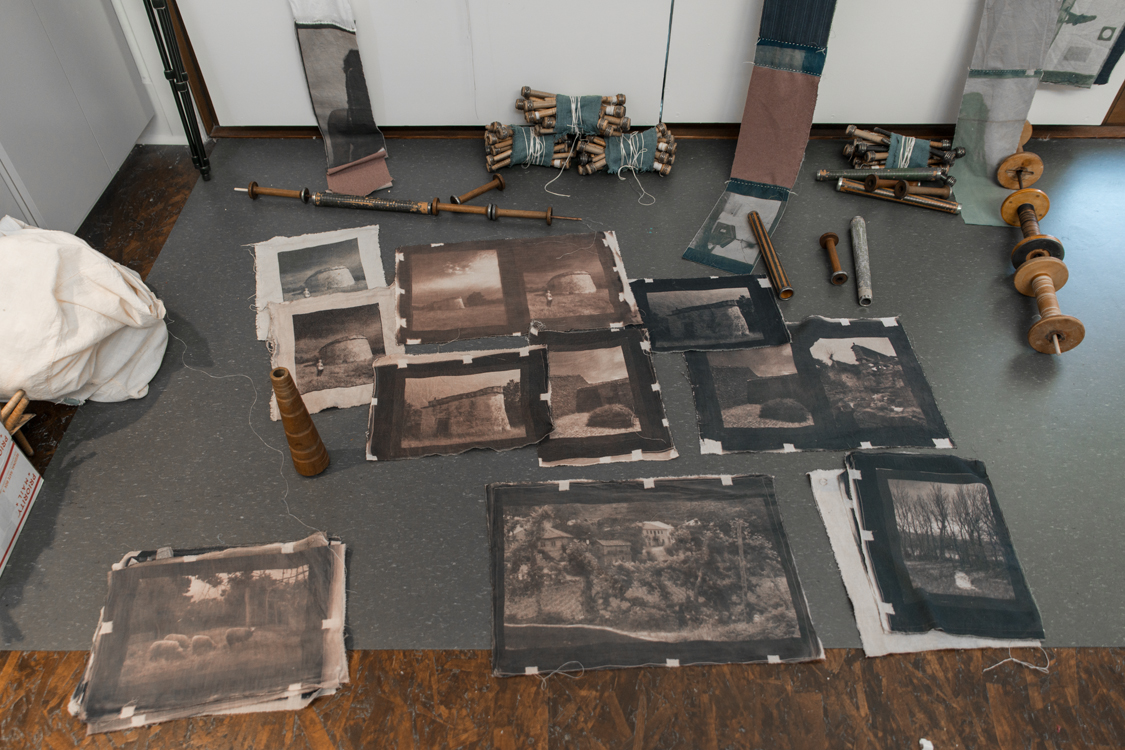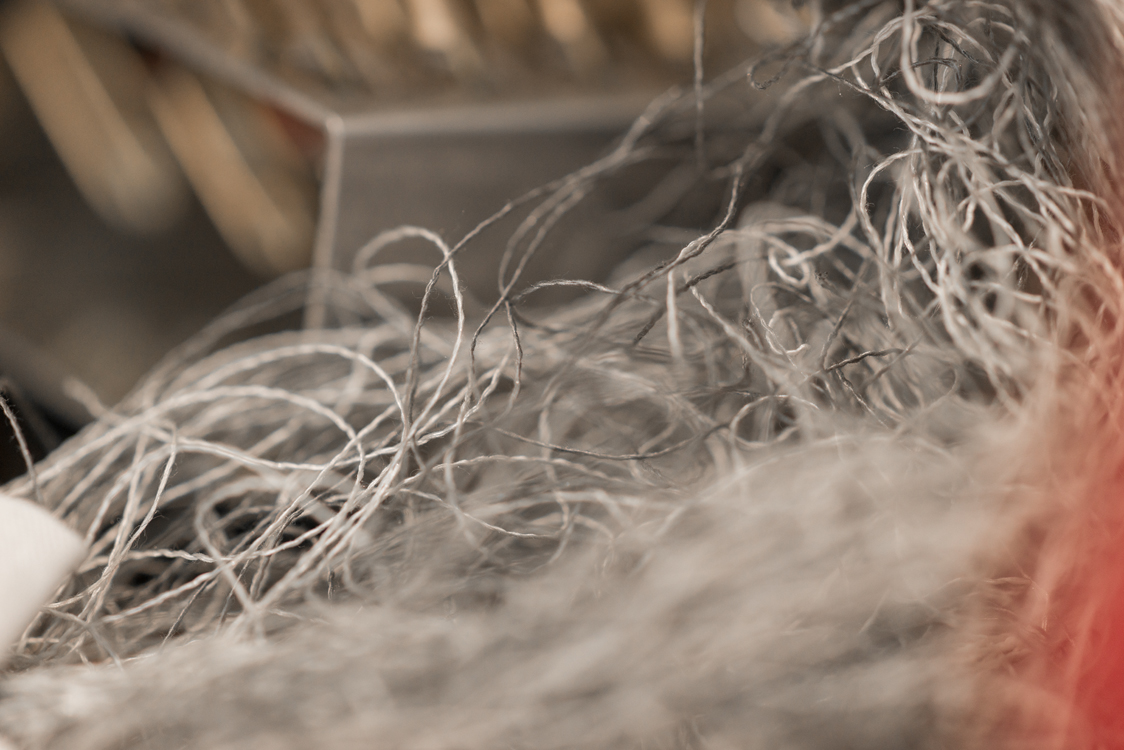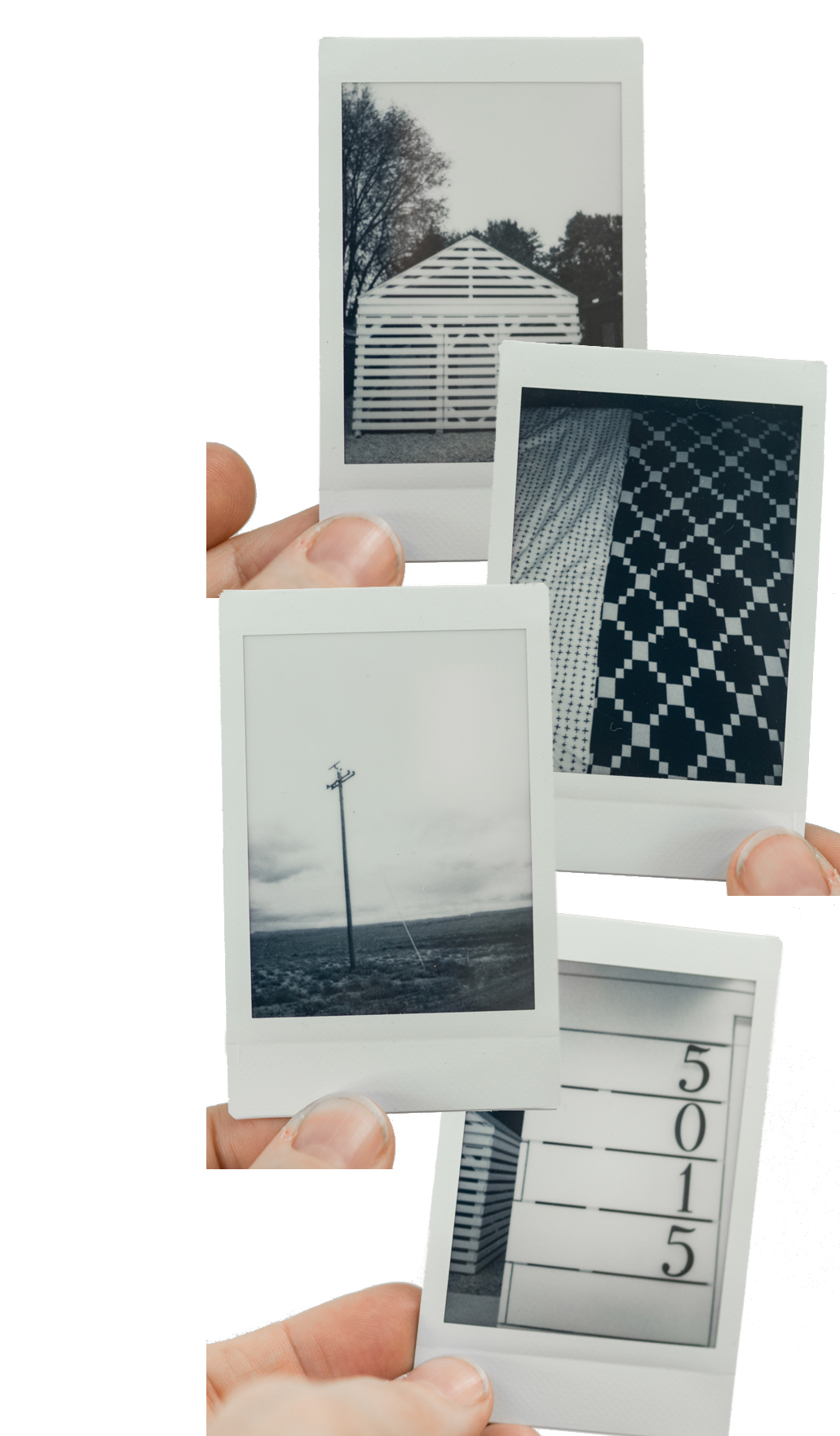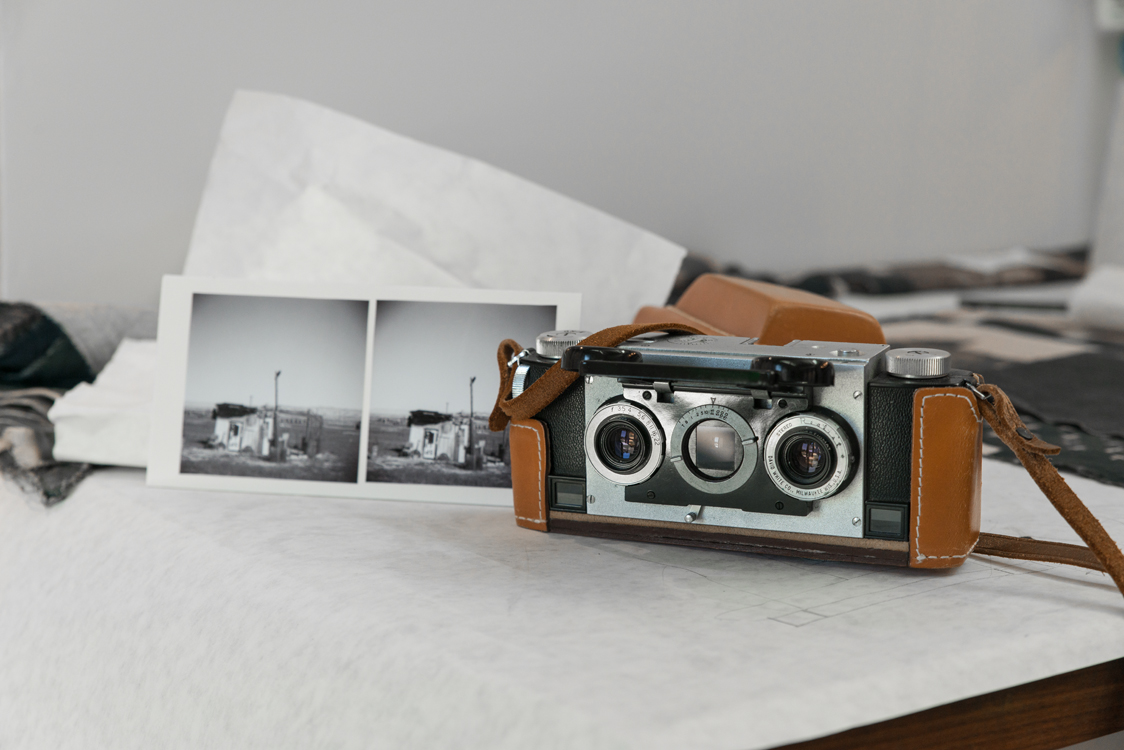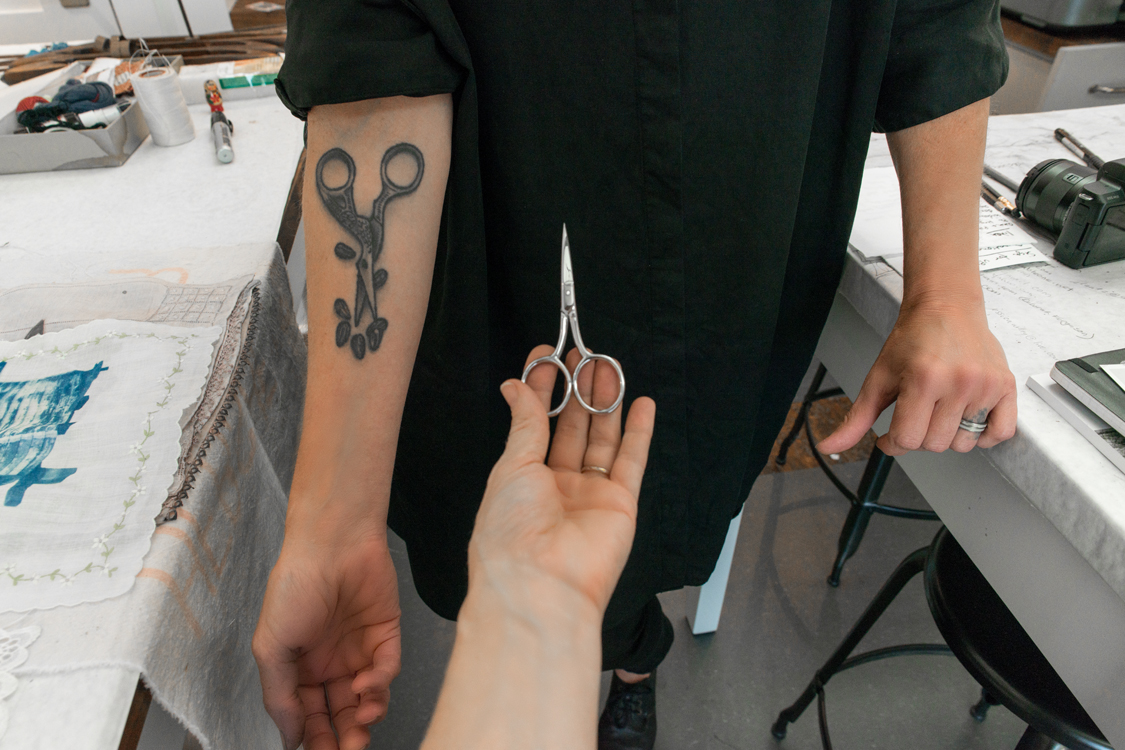Creators, Makers, & Doers: Cindy Steiler
Posted on 7/23/19 by Brooke Burton
Interview & Photography by Brooke Burton © Boise City Department of Arts & History
Cindy Steiler comes from a background and education in theater, an experience that informs how she tells visual stories through her work, weaving together themes of longing, memory, and sense of place. As a multi-disciplinary artist using textiles, found objects, and alternative photographic processes, Cindy speaks with us about crossing over from one career to another, about not fitting neatly into any one category, and about finding your footing. How do you do it? Ask yourself big questions, understand the present by looking at the past, and allow the journey to change you. Sometimes that journey is a cross-country drive and the opportunity to explore, rather than focus on the destination, a perspective mirroring Cindy’s artistic process: keep moving forward and take a chance to carve out a path of uncertainty and make the work you want.
You’re on a roll with artist residencies, what number is this?
This is 9th and I have a 10th one coming up.
Wow! Congratualtions! Are there certain kinds of locations, or settings you are drawn to?
I really like residencies that are project based or have a community engagement aspect. Also, I like either, tiny, tiny, rural places or historical places, because that’s my inspiration. I’ve had a lot of great residency experiences and every single one is special for some reason, but there’s a lot I like about the James Castle House. It’s incredible, everything from the history of the house, and being surrounded by the work of James Castle, to having access to the shed and the trailer, and having three whole months to work, which is the biggest gift ever. Generally, I think a month [long residency is] pretty standard.
One month isn’t quite enough to do a deep dive?
It’s hard. The first week you’re settling in, the last week you’re planning your departure, and so you really only have two solid weeks to work.
You drove out to Idaho from where?
Gainesville, Florida.
That is one heck of a road trip.
I wanted to bring all my stuff. I use so many antique and old materials, it’s difficult to source on the spot. My tools, printer, scanner, sewing machines, things that I have been collecting for the last year, like the antique shuttles and antique spindles. All of that.
I guess that would be pretty big baggage fee on an airline. How do you describe your work?
I combine textiles, alternative process photography, and found objects. I address concepts of memory and place, and I think there’s an aspect that documents and archives, too. It’s a mixture of old materials and old techniques that I hope present as accessible and contemporary, that’s my goal.
Is your work object driven?
It’s very rooted in material, I’m always going to flea markets and antique stores, and I collect things. Those spools and spindles sat around for years. I knew that I was going to do something with them, but I didn’t know what, then the opportunity presented itself. My inspiration comes from place, stories, and materials. Part of that is from my background in theater: props and set design. Telling a story in a different way, that’s kind of what I do.
Telling a story through visual art instead of words and actions, like in a script.
Yes, I’m thinking about reacting to people or to a place. I think my work is always intertwined with longing, too. That feeling—my favorite word, saudade, it’s the beauty of longing. It’s painful, but also beautiful.
The sublime of wanting.
It’s a Portuguese word. I could probably name every series I do for the rest of my life Saudade. When I took care of my grandmother, who had lost her memory, it really made me think differently about memory, and about identity. We are our memories.
Some people say ‘You are what you do,’ and I’m kind of mixed about that. But, “You are your memories,” I like that. No one else has my exact collection of memories.
Exactly. That’s why you see everything differently. Through memory you learn. Nobody sees the same thing the same way, no matter what it is. Memory is fickle, it changes, and it’s always evolving.
You use a lot of photographic process, and culturally, we use photographs to document: events, people; we try to hold onto memories through photography. How interesting is that dynamic?
Right, it’s a strange relationship. You should ask John Berger. He’s dead, but you should read his book Understanding a Photograph.
How do you use the antique portraits?
They are cabinet cards. I’m re-contextualizing them. They’re just kind of forgotten people. People most likely held the photos in their hands, but they are all gone, and there’s no name or anything.
That’s going to be me some day. [laughter] I’m going to be a random photo and nobody wrote my name on the back or the date and no one cares.
Exactly. It’s just the nature of things. Before there was photography, people just weren’t documented, except for the very, very wealthy.
I should be grateful for my little unnamed photo.
Yeah. The work is a nod to the past, I’m kind of a history buff; it helps understand the present. Also, I have this, like, weirdness, about thinking objects hold memory. Whether it’s a building or fabric, whatever. The sails of the boats I’m making use handwoven fabric made by a women for her daughter’s dowry.
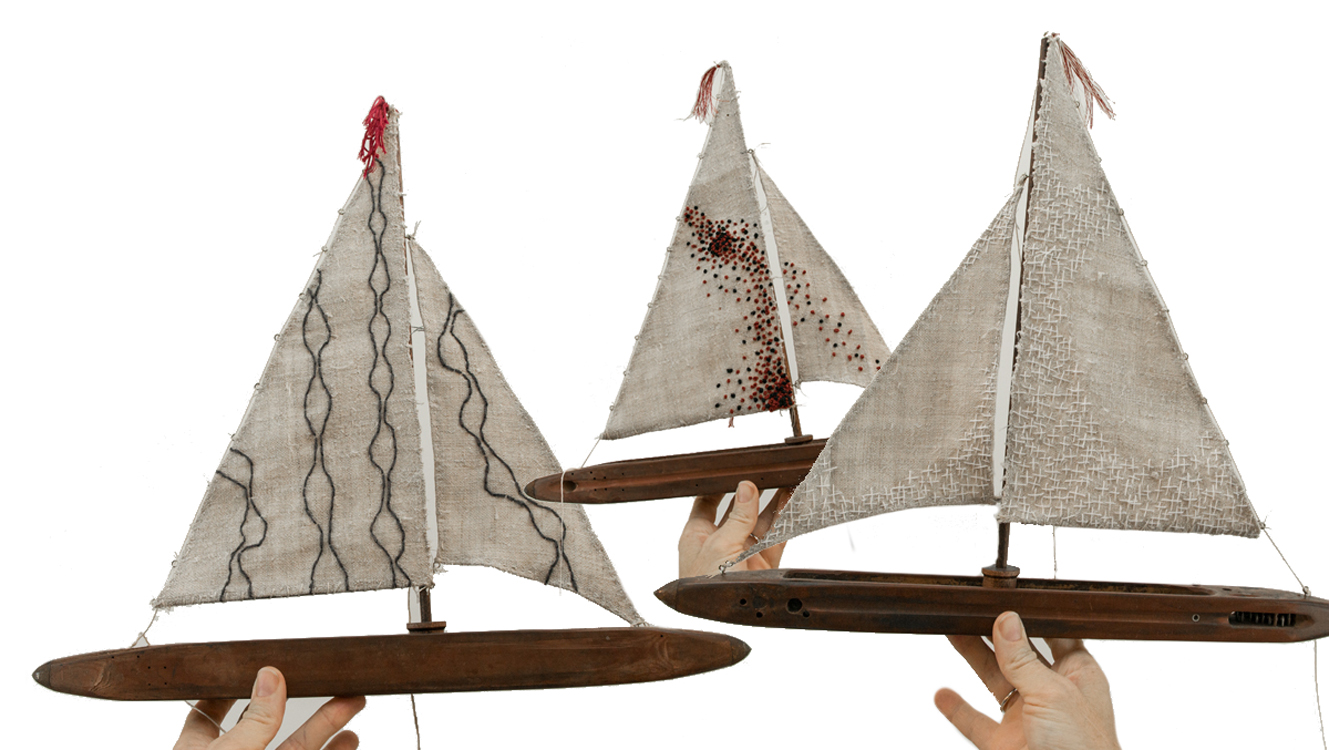
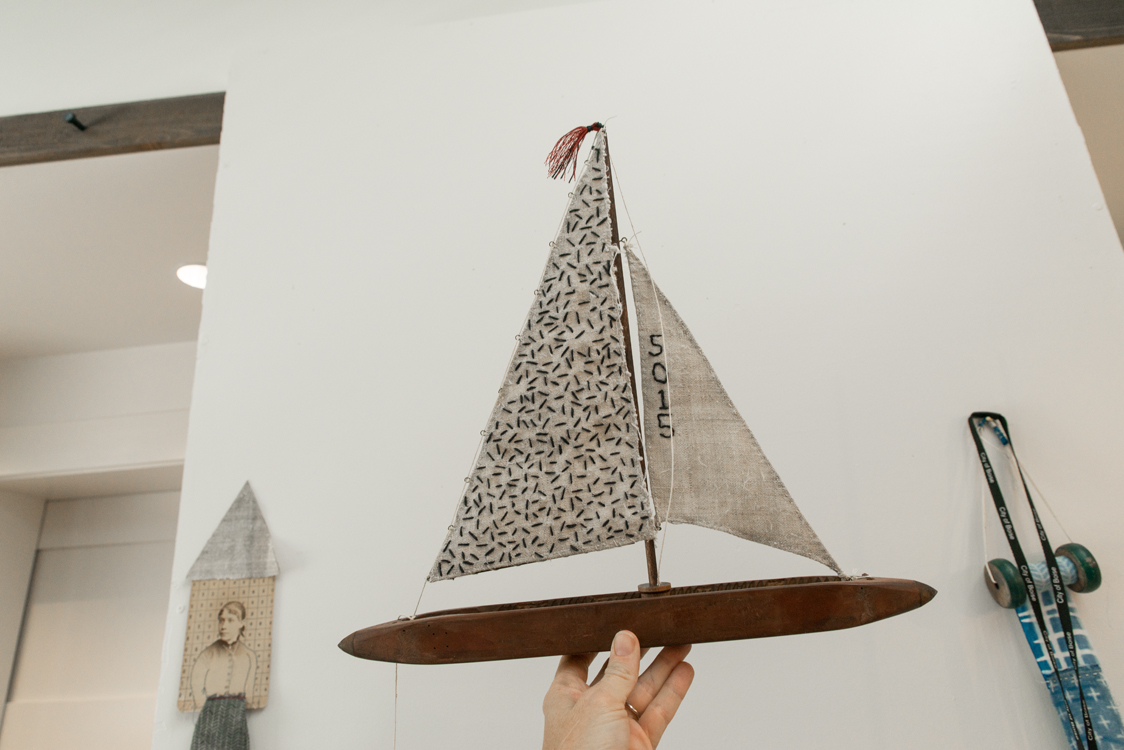 You’re not popping into the craft store to pick up 3 yards of cotton, this is like an heirloom.
You’re not popping into the craft store to pick up 3 yards of cotton, this is like an heirloom.
What would she think if she knew the fabric originally woven for her daughter’s dowry was never used? And somebody bought it and incorporated into artworks, and that it’s scattered all over the world?
How do you think she would feel about that?
I hope she would be thrilled.
My assumption is that she wove good wishes into the fabric, good intentions for her daughter. But, what if that wasn’t the case, what if she was angry? How about negative memories in objects, do you ever get that sense?
Well, I often wonder with the photos, like, what kind of people they were. While I embroider on them I have a lot of time to look at each [face.] What was their life like? Were they happy? Were they a good person? Were they petty and terrible and callous? You can’t really tell.
Probably yes to all of those things.
Exactly.
I notice embroidery is kind of having a moment in the arts?
There’s quite a few people doing it now. With the internet, once a few people start doing something, everybody starts doing it. Embroidery is making a comeback; I think it’s really wonderful because what I like about doing needle work, whether embroidery or sewing, knitting, crocheting, is that my great grandmother taught me all of those things, and she learned from her family. There’s a lineage, I’m getting placed on a continuum of knowledge that’s been passed down among women through time. And the stories that went along with it; she would tell me all sorts of stories while we were sitting and working: of her life in Germany, and of leaving Germany, how she worked in the coal mines, how she met my great grandfather. I learned so much about her through those times. I like, too, that [the embroidery] is almost a little rebellious.
How?
I’m doing it by choice. I’m not having to decorate my home in order to be thought of as a good woman or a good housekeeper. I’m using it in a different way for different reasons.
You’re taking it out of a domestic context and putting it into a new context. There’s some power in that, making a claim about how you choose to use it.
Yes, and it’s also slow. I like that. It’s meditative, and it’s the same reason I do film photography and alternative process photography because it’s slower. It’s more intentional.
I’m looking this photograph of a stone building, and you said that photo was taken on the perfect day?
I was working on a project in Portugal and we were on the hunt for raw sheep’s fleece. We drove out to a tiny village, and when I say village, I mean, like a handful of people. Just everything about that day— the sheep all have little bells, and that sound, and the smell. We saw this pigeon house and learned the story how years ago they would keep pigeons and believed that when you were sick, you needed to kill and eat a pigeon to get better. It’s an interesting place, it’s in the Mogadouro region of Portugal.
I love how you described the memory using sound and smell. How did you came to be an artist?
By accident. I went to school for set and costume design and there was a point when— theater is just all consuming.
Theater or theater people? [laughter]
Both. I was a single mother at the time, I had gotten divorced, and I just felt like I needed to be around more for my daughter. The theater is so demanding, just before a production opens, I’d be working all night. So, I left theater and ended up moving to Gainesville and started doing some of my own work, just for my own pleasure and a friend of my husband said, “You know, you should try putting that stuff on Etsy.” I didn’t know what Etsy was so I looked into it and put some stuff on and I had a lot of luck. The people at Etsy liked my work and I was [featured] on the front page a lot.
That must have been a huge encouragement!
I got offered some shows.
You are telling me you just decided to make some stuff and put it on Etsy and then you were offered gallery shows? This is a really cool story.
Yeah. It was fun. It was very strange. I was working hard at it, but at the same time it felt like this is was what I should be doing. I had really good fortune early on, I had a couple shows in LA, which led to people buying work, which led to more commissions.
Which leads to demand and prices going up?
A little bit. But I’m not so focused on selling my work anymore. It took me a while to break the mentality “time is money.” For me, it was starting to feel like production work, and I didn’t like the way that felt. I was ready to move on, but people kept asking for it, galleries kept asking for the same thing, same thing, same thing, and I just didn’t want to do it anymore. It felt kind of like a trap.
You’re not pushing yourself to evolve when you’re trapped.
Yeah. So I stopped selling on Etsy. I don’t mind selling my work, it’s nice to sell work, but I don’t make work to sell it, if that makes any sense. I don’t want to be in the mindset of making merchandise.
Good for you! One thing people keep saying is that you have totally moved in and taken over this space, more so than previous resident artists.
Yeah, every square inch.
I love it. You said you are working longer hours than you expected, sometimes into the wee hours, is that unusual for you?
It’s very weird for me.
What do you think that’s about?
I don’t know. It’s different than how I normally work and different for a residency, too, because usually I’m into exploring the surroundings more, but I’m just content to be here working. I don’t know if it had something to do with the drive out, because I did a little bit of sightseeing: Craters of the Moon, Bruno Sand Dunes, up to Garden Valley, and Kirkham Springs, but when I settled in, I was happy to settle in.
Do you think the energy has something to do with the house?
It feels like— I don’t even know how to explain it. I’m not a woo-woo person.
She’s not a woo-woo person.
I’m not generally into magical thinking, I’m a need to see it to believe it kind of person.
Are you skeptical?
Yeah.
But you feel like there’s something a little woo-woo going on here?
Maybe. The pigeon was strange. It could be coincidence. I had gone to the trailer, which is off-site, to do some photos and sketches, and also to meditate. When I got back, I was sitting right here at this table where we’re sitting, the door was open and a pigeon walked in and stood in right in front of the work I’m making, then he walked into the gallery. He stayed for a week. He would come and go, in and out; we were just getting ready to name him, when he flew away.
I’m a magical thinker. I think that’s James Castle visiting you.
That’s what a lot of people have said.
Since you didn’t go to school for art, does that mean you are self-taught?
I wouldn’t feel comfortable saying I am totally self-taught. The first alternative process I learned was wet plate, because I love tin types. I learned from John Coffer. He lives in Upstate New York, totally off the grid, and has traveled across the United States in a horse and carriage studying different archives to generate [a method] for wet plate again and —
Wait. Just to clarify. Horse and carriage?
Horse and carriage, yeah.
I’m seeing a parallel here, to you driving from Florida to Idaho. Continue.
He’s super interesting, he has no electricity. His photos are really beautiful, so I wrote to him— you have to write a letter and mail it because he doesn’t do e-mail, I told him I wanted to buy his manual, which is handwritten and photo-copied at the post office. I sent a check and he sent me the manual. I taught myself based on his handwritten [instructions]; it was very true, authentic to the origins of the process. After that I decided to go to the Center For Alternative Process Photography at the Penumbra Foundation in New York. I studied wet plate there, and after wet plate, everything is easy.
I was gong to say, as far as alternative processes go, you started with something extremely toxic and temperamental, rather than something easy like cyanotypes. I find that endearing.
I like to do things the hard way, I guess.
What are some of the challenges you’ve faced?
The biggest challenges are, just myself, insecurity. I’m in a weird spot because I’m not a classically trained artist but I’ve had too much education to be an outsider artist. I’m not an academic—
Which totally surprises me because you’re wearing all black, and that is the standard academic artist outfit. [laughter]
It’s a strange place to be. I don’t fit neatly into any category and it’s the same with the work I do. It’s multi-disciplinary. Part of the insecurity comes from that.
Do you have to talk yourself through those moments?
I do. Luckily, I have an amazing and supportive husband who can set me straight. I don’t know that I would be doing this without him. And there’s nothing I want to do more.
What would you tell other artists about overcoming insecurities?
I don’t know that I’m qualified to give any advice on that. It’s still a weekly thing that I deal with. I think being an artist is difficult. You’re choosing a path of uncertainty, you’re making work, and putting it out for the world to see and judge. It’s constantly opening yourself up to rejection and it’s not for the weak of heart.
I think all artists deal with that, even the ones we look up to, idealize. Who are some of your favorite artists?
I love Anna Hamilton’s work. Ruth Asawa. I love El Goya. I’m all over the place — I love James Castle’s work obviously, Bill Traylor. The film The Mirror, by Tarkovsky. There’s certain works, I can’t even explain. Certain artists resonate with me on such a deep level. The thing is, does the work make me cry? Can a work stir that kind of emotion in me? I never thought Goya would be one of them but when I saw his Black paintings at the Prado, I had to leave the room.
Where is the Prado?
It’s in Madrid. It’s an incredible museum. They had all the Black Paintings there, and they also have Picasso’s Guernica. One in particular, the Drowning Dog, some people just call it The Dog painting, was super stirring. It was the same with Ruth Asawa’s work, when I saw it in person the first time, it knocked the wind out of me. But I don’t think any one artist can make everyone feel that way.
No. But it’s magnificent when it happens. What’s something you’re proud of?
I’m proud of my daughter. My daughter is awesome, but if you’re talking art related, I’m proud of the fact that I keep doing it. I think my goal is to keep learning, to keep going to interesting and inspiring places and to keep meeting interesting and inspiring people. Part of it is heart breaking, though, because I’m meeting people I really love and respect, but it’s temporary.
Being a visitor means you always leave?
Right. Just knowing people all over makes the world get smaller. Every place I go changes me and makes me stronger. Driving across the country was so empowering, to do it by myself, to stop at interesting places and not just speed out here. I learn something about myself with each excursion; it helps me figure things out, all the big questions.
Like?
Why am I here.
Should I be here?
I feel like I’m figuring it out through following this path. If that changes, maybe I’ll want to put roots down again. I hope I have the good fortune to continue. I’ve come, in a roundabout way, to just a make the work I want to make.
You’re in a sweet spot, then!
I am in a sweet spot. My life is cooler than I ever thought it would be.
Do you ever imagine yourself as a little girl, and what she would think of you now?
I think that if my younger self could see this, she would have had an easier time.
That makes me feel very nostalgic, and sad, and happy.
Yeah. Sometimes life just turns out better than you expect it to and that’s a good thing.
The saudade of our youth.
These are happy tears.
Thank you. We’re going to stop there because we can’t—
We’re done.
We’re crying. We’re done.
North End
July 25, 2019
James Castle House Artist-In-Residence
This interview has been edited and condensed for clarity.
Creators, Makers, & Doers highlights the lives and work of Boise artists and creative individuals. Selected profiles focus on individuals whose work has been supported by the Boise City Dept. of Arts & History.
